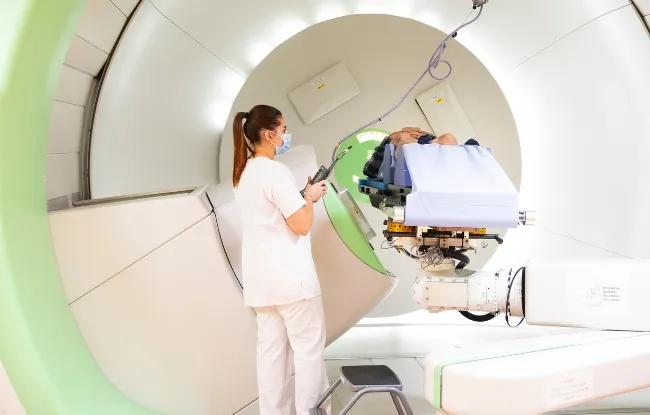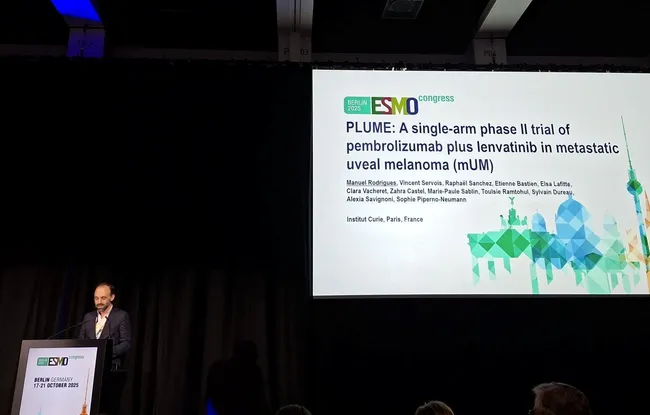- Home >
- Institut Curie News >
- When proton therapy meets aerospace: Institut Curie pushes the boundaries of innovation to simulate the space environment
With just a few days to go before the Paris Air Show, which will take place from June 16 to 22, Institut Curie is highlighting a little-known aspect of its scientific expertise: the impact of its technologies beyond the field of healthcare. As the leading proton therapy center in France, Institut Curie makes its cutting-edge technologies available to leading industrial players such as Airbus, Nuclétudes (a subsidiary of ArianeGroup) and TRAD. These aerospace leaders call on Institut Curie's experts and state-of-the-art equipment to test the resistance of electronic components under extreme conditions, simulating the space environment.
"As the historic birthplace of radiotherapy, we are proud to see our technologies contributing to large-scale scientific projects in the aerospace field. These partnerships, although distant from our traditional medical fields, illustrate what our cutting-edge equipment can do for innovation and society as a whole," explains Prof. Gilles Créhange, head of the Radiation Oncology Department at Institut Curie. “This ability to combine disciplines and push boundaries is an integral part of Institut Curie's DNA.”
A pioneer in France, Institut Curie's Proton Therapy Center1 is dedicated to the treatment of complex cancers, particularly in children, adolescents and young adults, or in locations close to sensitive organs. It is the first center of its kind in France and one of only three in the country. The center treats more than 1,200 patients per year and draws on unique expertise combining medical innovation, engineering and applied research in collaboration with industrial and scientific partners.
Equipped with the most advanced facilities in Europe, the center, located on the Orsay campus (Essonne), is not only a benchmark in the high-precision treatment of certain cancers. It is also a unique tool for research outside the medical field.
This exceptional expertise now attracts big names in the aerospace industry, such as Airbus, Nuclétudes (a subsidiary of ArianeGroup) and TRAD Tests & Radiations, which conduct advanced experiments there outside treatment hours.
Thanks to Institut Curie's proton irradiator, researchers and technicians can accurately recreate the extreme conditions encountered in space. These intense levels of protons, comparable to those experienced by satellites or space probes, make it possible to test the resistance of onboard electronic components and sensitive materials.
"From our very first experiment in 2020 on Institut Curie's proton irradiator, we identified strong potential linked to the characteristics of the beam and our ability to control it. This expertise enables us to provide our customers in the aerospace sector with the best possible support in designing electronic equipment that can withstand the severe stresses of cosmic radiation," said Florent Miller, Executive Vice President at Nuclétudes (a subsidiary of ArianeGroup).
"Access to Institut Curie Proton Therapy Center is a strategic asset for TRAD's competitiveness. Being able to test our components there under extreme conditions, comparable to those in space, is essential. This partnership illustrates the convergence between two seemingly very different fields—medicine and space—made possible by the vision and perseverance of Institut Curie and the CNES (French National Center for Space Studies). In a context of scarce infrastructure due to budget constraints, we are proud to contribute to the sustainability and development of this unique scientific platform," said Christian Chatry, Chairman of TRAD Tests & Radiations.
Expert opinion
Dr. Matthias Maurer, astronaut with the European Space Agency (ESA) Astronaut Corps, engineer and doctor of materials engineering

"Thanks to the cutting-edge technologies of Institut Curie’s Proton Therapy Center, it is possible to study in great detail how cosmic radiation can disrupt or even damage onboard electronic components. These disruptions can range from simple calculation errors to temporary malfunctions or irreversible failures. The long-term impact of this radiation is also a major issue: it can gradually degrade system performance, compromising their reliability over time. This research is fundamental to ensuring the safety of space missions.
We are exploring new avenues for scientific collaboration with Institut Curie in order to continue and strengthen this momentum and to accelerate innovation in the aerospace field together.”
A bold strategy for scientific and technological development
These collaborations, carried out outside patient treatment hours, draw on the expertise of Institut Curie's technical teams and enable the institution to generate new resources. Several positions are now directly funded by these projects, helping to support the Institut's research and medical projects.
"Opening up our technological platform to practical industrial applications outside the field of healthcare fully illustrates our desire to promote the scientific expertise of Institut Curie beyond oncology. Identifying grassroots innovations and helping them scale is a key challenge,” says Dr. Cécile Campagne, Director of Institut Curie’s Technology Transfer Office and Deputy Director of Carnot Curie Cancer. “In an increasingly complex global context, these collaborations also strengthen France's position on the international stage by offering unique solutions to the major challenges of tomorrow, whether medical, industrial or space-related.”
[1] The Proton Therapy Center at Institut Curie forms an integral part of the Oncology Radiotherapy department at Institut Curie.
Photography : Proton therapy center at Institut Curie (Orsay). © Institut Curie / VOISIN



